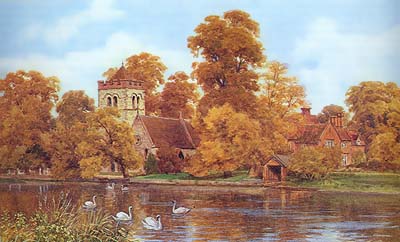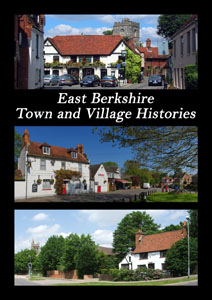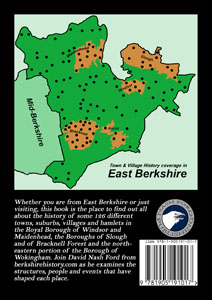RBH: History of Bisham, Berkshire (original) (raw)
 Bisham
Bisham
Spirits & Earls of Salisbury
Bisham village was early chosen as the site of a preceptory (like a monastery) for the Knights Templar who were given the manor in the 1140s. At the centre of the complex was what is currently called the �abbey� � actually a fine example of a medieval manor house with later additions. The main feasting hall was built for these crusading knights-cum-monks in about 1260, along with a separate circular chapel, the remains of which are apparently now buried under the tennis courts. The order was suppressed in 1307, when the Crown took the place over and used it as a luxurious prison for King Robert the Bruce�squeen and daughter, captured during the Scottish Wars of Succession.
Eventually, in 1335, the manor came into the hands of William, 3rd Baron Montacute. He was a close friend of King Edward III and was sent to arrest the Earl of March who had had Edward�s father murdered. He extended the end of the Templar hall with living quarters and a small cloistral arcade that can still be seen today. In 1337, Montacute was rewarded with the Earldom of Salisbury and, in the same year, he founded apriory for Austin canons immediately adjacent to, and completely dominating, his manor house at Bisham. It was only briefly raised to the status of an abbey just before its dissolution, but this is the name that has survived, but transferred to the manor house. Bisham was an ideal location for a large-scale building project like this, as many villagers were then employed in quarrying and supplied much of the stone forWindsor Castle. The name of Quarry Woods still reminds us of the quarry�s location. The eerie wood was later the inspiration forKenneth Grahame�s �Wild Wood� where Mr Badger lived in his novel, the �Wind in the Willows�. Grahame wrote his famous book at nearbyCookham Dean.
The foundation stone of Bisham Priory was laid by King Edward III himself and the brass plaque recording the event can now be seen reused in Denchworth Church, near Wantage. The Priory held minor relics of Saints Cosmas and Damian, but never became a major pilgrimage centre and, despite the resident patronage of the Salisburys, remained a relatively poor monastery. However, it was soon to become the family mausoleum and the medieval monuments there must have rivalled those at places like Tewkesbury Abbey in Gloucestershire:
- William Montacute, 1st Earl of Salisbury, who was killed in a joust in 1344, and his wife.
- William, died 1383, son of William Montacute, 2nd Earl of Salisbury.
- William Montacute, 2nd Earl of Salisbury, who died in 1397 leaving instructions for suitable monuments to be erected to himself, his son and his parents.
- John Montacute, 3rd Earl of Salisbury, who was beheaded by a mob for attempting to restore King Richard II to his throne during the �Epiphany Rising� in 1400, and his wife.
- Thomas Montacute, 4th Earl of Salisbury, the most skilful English soldier to fight in the Hundred Years� War with France, and his two wives. He was killed at the Siege of Orleans in 1428 when a cannon ball struck him in the face while he stood at an open window. A depiction of him, with the three-tiered monument described in his will, may be seen in the east window of Bisham Church.
- Richard Neville, 5th Earl of Salisbury, a leading Yorkist in the Wars of the Roses who was killed after the Battle of Wakefield in 1460, and his wife, Alice, daughter of the 4th Earl. His head was stuck on a spike on Micklegate Bar in York but the rest of his body was eventually brought to Bisham. His effigial monument has survived and, for reasons unknown, can be seen in Burghfield Church, near Reading.
- Sir Thomas, son of Richard Neville, 5th Earl of Salisbury, who was also killed at Wakefield in 1460. He was also decapitated.
- John Neville, Marquess of Montague, son of Richard Neville, 5th Earl of Salisbury, who was killed at the Battle of Barnet in 1471.
- Richard Neville �Warwick the Kingmaker,� 6th Earl of Salisbury and 16th Earl of Warwick. This was the man whose support determined whether King Henry VI or King Edward IV sat on the Throne. He was killed at the Battle of Barnet in 1471.
- Prince Edward, 8th Earl of Salisbury and 18th Earl of Warwick, son of Prince George, Duke of Clarence. He was executed in 1499 because he was a rival for King Henry VII�s throne.
- Arthur Pole, son of Sir Richard Pole and Princess Margaret, Countess of Salisbury, who died 1528.
In the early 15th century, the manor passed to the great northern family of Neville, whose central role in the Wars of the Roses cannot be overestimated, in particular the actions of King Edward IV�s cousin, the all-powerful Earl of Warwick �the Kingmaker�. Although they spent much time on their Yorkshire estates and in London, their Southern country residence was Bisham Manor. The Bull Inn at Bisham was named after their family symbol. Built for the village mason who put up the church, it is said to have been a pub for about six hundred and fifty years, with reputed visits from Templars, Henry VIII and Elizabeth I. Within, there is a superb stained-glass window showing the head of a large black bull surrounded by crests of the lords of the manor.After the Wars, Princess Margaret, Countess of Salisbury � the niece of Edward IV and Richard III � eventually managed to regain her house at Bisham and built the marvellous dovecote, still to be seen today, in order to provide sustenance for her household through the winter. Being a good Catholic, the Countess rebuked the commissioners who closed and then demolished the Priory in 1536. She is said to have tried to save the family monuments by gathering them together in the old feasting hall.
After the Countess�s execution, resulting from her claim to the Throne, Bisham came into the hands of Sir Philip Hoby and his brother, Sir Thomas. They were both English ambassadors in Europe and erected the rest of the house, including the tower. Sir Philip was amongst the many courtiers of King Henry VIII who were painted by Hans Holbein the Younger. Through Sir Thomas� wife,Lady Elizabeth, the brothers later had connections with some of the most influential people at the Elizabethan Court, including her brother-in-law, Lord Burghley, the Queen�s chief advisor. As Princess Elizabeth, the Queen had been kept in their care at Bisham for several years. She apparently used to drink from the holy well named after her and planted a mulberry tree still standing in the grounds. Elizabeth, Lady Hoby is said to have been a singularly stern individual. Being highly educated, she took to tutoring her own children. One son, however, was such a disappointment to her that she could not help but lose her temper with him. One day she is said to have beaten him to death with a ruler for having accidentally made ink blots all over his exercise book. Herrepentant ghost is often seen around the Abbey, ceaselessly washing her blood-stained hands.
Lady Elizabeth�s monument, in the southern Hoby Chapel of Bisham Church, is one of the largest and most spectacular of any to be found outside a cathedral. It features the lady and all her children. Lady Hoby organised both this monument and her own funeral down to the last detail, even writing to the College of Arms to confirm her heraldic rights and privileges. Her husband and brother-in-law recline alongside her with hobby hawks at their feet. It is a very early monument of its type, probably made in France. However, it is the swan-covered obelisk to her daughter-in-law, Margaret Carey Hoby, which commands one�s attention. This lady was the daughter of Queen Elizabeth I�s cousin, Lord Hunsdon, and she was visited at the �Abbey� by her royal relative. The early 17th century heraldic windows trace the Hoby family history.
In 1780, a younger branch of the Vansittart family from Shottesbrooke Park purchased the Bisham estate. They later became the Vansittart-Neales. They are particularly remembered by a sad monument in the church to their heir, an Eton boy who died of appendicitis at the age of only fourteen in 1904. He is represented along with his spaniel, Norman, sculpted from life. He was one of several young Vansittarts and their heirs who died in tragic circumstances, giving rise to talk of a curse on the owners of the house. After the Second World War, Bisham Abbey house was lent, and later sold, to the Central Council for Physical Recreation as a sports training centre in memory of the two heirs killed in the War. The family then moved into the adjoining Bisham Grange. The Abbey house and its grounds are now one of the country�s National Sports Centres.
Read more history of Bisham and other settlements in the parish in David Nash Ford's book, 'East Berkshire Town and Village Histories'. Click to Order direct from the Author.
|  |
|  | NEW BOOK Whether you are from East Berkshire or just visiting, this book is the place to find out all about the history of some 126 different towns, suburbs, villages and hamlets around Windsor and Maidenhead, Slough and Bracknell Forest. Join David Nash Ford from berkshirehistory.com as he examines the structures, people and events that have shaped each place. Some of these histories were first published in part here on this website, but they have all been considerably expanded and are joined by many new histories of places often missed by historians, including those which only joined Berkshire in 1974 or later. Click for full details and purchase options. | |
| -------------------------------------------------------------------------------------------------------------------------------------------------------------------- | ------------------------------------------------------------------------------------------------------------------------------------------------------------------ | ----------------------------------------------------------------------------------------------------------------------------------------------------------------------------------------------------------------------------------------------------------------------------------------------------------------------------------------------------------------------------------------------------------------------------------------------------------------------------------------------------------------------------------------------------------------------------------------------------------------------------------------------------------------------------------------------------------------------------------------------------------------------------------- | |
| NEW BOOK Whether you are from East Berkshire or just visiting, this book is the place to find out all about the history of some 126 different towns, suburbs, villages and hamlets around Windsor and Maidenhead, Slough and Bracknell Forest. Join David Nash Ford from berkshirehistory.com as he examines the structures, people and events that have shaped each place. Some of these histories were first published in part here on this website, but they have all been considerably expanded and are joined by many new histories of places often missed by historians, including those which only joined Berkshire in 1974 or later. Click for full details and purchase options. | |
| -------------------------------------------------------------------------------------------------------------------------------------------------------------------- | ------------------------------------------------------------------------------------------------------------------------------------------------------------------ | ----------------------------------------------------------------------------------------------------------------------------------------------------------------------------------------------------------------------------------------------------------------------------------------------------------------------------------------------------------------------------------------------------------------------------------------------------------------------------------------------------------------------------------------------------------------------------------------------------------------------------------------------------------------------------------------------------------------------------------------------------------------------------------- | |
